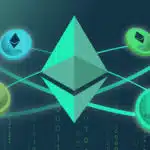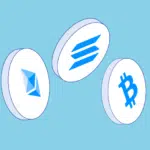Blockchain development transformed the way businesses operate. While cryptocurrency coins play an integral role as an investment asset, equally important and useful are the tokens.
This article delves into what are tokens, what is tokenization, what is ERC for Ethereum, the ERC token standards, and more.
Let’s get started!
What are tokens?
Tokens also referred to as crypto tokens, are essentially units of value that blockchain projects build on top of the existing blockchain network. Tokens are a completely different class of digital assets, they don’t have a native blockchain.
Cryptocurrencies are native to the particular blockchain while tokens are developed by platforms that build on top of these blockchains. For example, Ether (ETH) is the native cryptocurrency of the Ethereum blockchain. While Ether belongs to the Ethereum platform, there are other blockchains that use Ethereum blockchain.
LINK, COMP, and DAI are some examples of crypto tokens built with the Ethereum blockchain.
What is tokenization?
In simple language, tokenization refers to the process of changing an asset or its ownership into special units known as tokens. It is generally used for transforming the ownership and right of assets into a digital form. This process enables converting even physical, indivisible items into tokens.
For instance, tokens enhance data security of sensitive information by replacing it with unique, non-confidential information. In this case, tokens do not contain the original data but consist of similar characters. To restore and view the actual information, users must access the tokens linked to originals stored elsewhere. Token creation involves various techniques, such as cryptographic functions and randomly-generated numbers, that make them ideal for storing sensitive personal and financial information.
What is ERC for Ethereum?
ERC expands to Ethereum Request for Comments. It’s similar to technical documents that outline research, innovations, and methods that are applicable to developers and users who wish to participate in technical discussions of improvements, fixing errors, defining standards, and more. Sometimes, they either keep or freeze the inclusive to end in an EIP.
Now, the question is who has the authority to edit or review these ERC documents? Well, anyone including Ethereum smart contract programmers who write these technical details, can review them periodically and add comments for further improvement.
What are ERC token standards?
ERC token standards specify the interface that supports the smart contract implementing the token. Their purpose is to create wallets or systems that are protocol-agnostic.Initially, most of them were creating their own tokens and custom interfaces. The Ethereum community reviews the rules and updates them periodically. The ERC token standards are inclusive of the same token and the ERC can vary with each one depending on characteristics and purpose.
Before moving to ERC standards, let’s understand what smart contracts are capable of:
- Programmers create smart contracts by adhering to the rules of the underlying language, such as Solidity, to leverage the potential of the Ethereum network.
- Smart contract standards include token standards, registry details, library names, and more.
ERC-20 Token Standard
Developed in 2015, ERC-20 tokens were introduced into the Ethereum ecosystem in 2017. ERC-20 standards set the rules for the development of fungible tokens on the Ethereum blockchain.
While ERC-20 tokens represent fungible items, in standard one ERC-20 simply saves the balance of tokens assigned in an account and exposes functions that allow to manipulation of the tokens.
Ethereum requires a strong standard to bring uniformity in the operations to support token development on the blockchain network. ERC-20 tokens fulfill this role.
Characteristics of ERC-20 tokens:
- ERC-20 tokens are one of the popular interfaces for implementing fungible tokens.
- Each ERC-20 token is equal to the same value regardless of its structure and features
- The ability of an asset to be exchanged for assets of the same value is referred to as fungibility.
- ERC-20 tokens’ most popular applications include stablecoins, governance tokens, and ICOs
ERC-721 standard
As a first step to understanding ERC-721, you must be aware of Non-fungible tokens – NFTs. Dieter Shirley, founder of CryptoKitties proposed the development of a new token type for supporting NFTs. Specializing in NFTs, ERC-721’s rules, which can be used for representing any digital asset on the Ethereum blockchain, were finally approved in 2018. ERC-721 can represent the following:
- A unique digital artwork
- Social Media Posts
- In-game collectibles
- Gaming characters
- Any animated character or other items
Characteristics of ERC-721 tokens:
- They represent the non-fungible tokens, NFTs.
- They cannot be exchanged for anything of the same value as they are one-of-a-kind
- ERC-721 tokens are most popular with NFTs in digital art
ERC- 1155 – Multi-token standard
A comprehensive token standard for Ethereum smart contracts was introduced by combining the features of ERC-20 and ERC-721. It’s a standard interface that supports all forms of fungible, semi-fungible, and non-fungible tokens and other configurations under a common smart contract.
With ERC-1155, you can address all your token development needs and solve your problems in a single interface. The whole idea of developing ERC-1155 was to develop a robust smart contract that would manage different ERC tokens. In addition, ERC-1155 improves the overall functionality of previous ERC tokens, making Ethereum more efficient and scalable.
Characteristics of ERC-1155 tokens:
- ERC-1155 is a smart contract interface that supports fungible, semi-fungible, and non-fungible tokens
- ERC-1155 can perform the tasks of ERC-20 and ERC-721, even both simultaneously
- The token can be used for creating NFTs, redeemable shopping vouchers and ICOs, etc
- Each token can represent a different value based on if it’s fungible, semi-fungible, or non-fungible
Final thoughts
Tokens play a significant role in the blockchain economy. The rationale behind Ethereum introducing the token standards is to tackle the various dynamic changes that keep taking place in the blockchain arena. Each of these standards serves a specific purpose and offers benefits to the users and developers. Although ERC-20, ERC-721, and ERC-1155 Ethereum standards currently exist, it is anticipated that additional standards will emerge in the future to meet evolving business requirements.
Posted in Blockchain, Ethereum, Technologies





